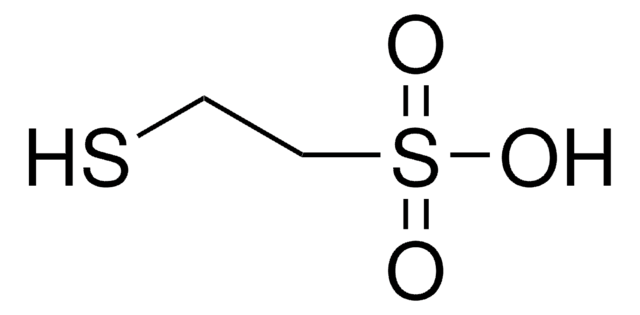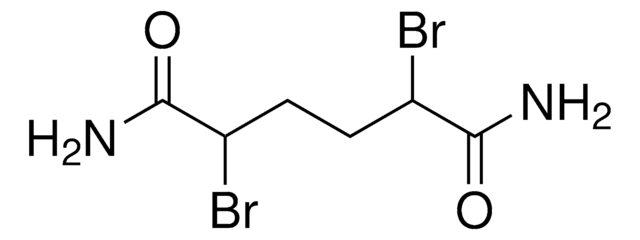M1511
Sodium 2-mercaptoethanesulfonate
analytical standard, ≥98.0% (titration)
Sinónimos:
2-Mercaptoethanesulfonic acid sodium salt, Coenzyme M sodium salt, HS-CoM Na, MESNA
About This Item
Productos recomendados
grade
analytical standard
Quality Level
assay
≥98.0% (titration)
technique(s)
HPLC: suitable
gas chromatography (GC): suitable
application(s)
clinical testing
format
neat
SMILES string
[Na+].[O-]S(=O)(=O)CCS
InChI
1S/C2H6O3S2.Na/c3-7(4,5)2-1-6;/h6H,1-2H2,(H,3,4,5);/q;+1/p-1
InChI key
XOGTZOOQQBDUSI-UHFFFAOYSA-M
¿Está buscando productos similares? Visita Guía de comparación de productos
General description
Application
- Quantification of sodium 2-mercaptoethanesulfonate (MESNA) from human samples by micellar electrokinetic chromatography (MEKC) coupled with UV detection and in-capillary derivatization of MESNA
- Development of a fluorescence-enhanced histidine stabilized gold nanoclusters (His-Au NCs) based probe for the detection of sodium 2-mercaptoethanesulfonate in uromitexan samples
- High-performance liquid chromatography-tandem mass spectrometric based bioanalysis of sodium 2-mercaptoethanesulfonate in rat plasma samples
- To quantify sodium 2-mercaptoethanesulfonate in two of its pharmaceutical preparations (injections) by surface-enhanced Raman scattering (SERS) using gold colloid as a probe
Other Notes
signalword
Warning
hcodes
Hazard Classifications
Eye Irrit. 2 - Skin Irrit. 2 - STOT SE 3
target_organs
Respiratory system
Storage Class
11 - Combustible Solids
wgk_germany
WGK 2
flash_point_f
Not applicable
flash_point_c
Not applicable
ppe
dust mask type N95 (US), Eyeshields, Gloves
Elija entre una de las versiones más recientes:
¿Ya tiene este producto?
Encuentre la documentación para los productos que ha comprado recientemente en la Biblioteca de documentos.
Los clientes también vieron
Nuestro equipo de científicos tiene experiencia en todas las áreas de investigación: Ciencias de la vida, Ciencia de los materiales, Síntesis química, Cromatografía, Analítica y muchas otras.
Póngase en contacto con el Servicio técnico














